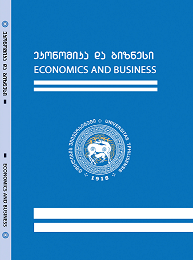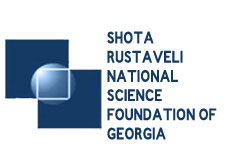
Referential and Reviewed International Scientific-Analytical Journal of Ivane Javakhishvili Tbilisi State University, Faculty of Economics and Business

Deposits, Banks and “The Initial Accumulation of Capital” in Post-communist Georgia
In the post-communist transitional period, the administrative-commanding ("socialist") economy is being transformed into a capitalist market economy. "The initial accumulation of capital" is a part of this process, which has been carried out to a certain extent in every post-communist country and was expressed in deep socio-economic differentiation of the society. In Georgia it had a particularly acute nature in Georgia and the banking system was organically involved in this process. In the work there is given an attempt to answer the following questions: How was the new Georgian capital created? What are the ways of enriching a small part of the population and impoverishing of the vast majority of the population? Where did the huge amount of money deposited in banks by the population during the Soviet period go? To whom was transferred the largest share of the former state property? Based on the conducted research, the following conclusions are made in the article: In the Soviet perComparative Analysis of Some Economic Indicators of Post-Soviet Countries in the South Caucasus
The paper deals with the comparative analysis of some economic indicators of the post-Soviet countries of South Caucasus, Georgia, Azerbaijan and Armenia. According to the conclusions obtained from the survey: First, in 1990, the volume of GDP per capita was the Azerbaijan, which did not greatly surpass Georgia, the Armenian data was more modest. In 2017 Azerbaijan increased this index to ten times, Georgia doubled it, and Armenia was able to make it even better to five times; Secondly, the rate of growth of economic development of countries is radically different. The average annual growth rate of economic growth was 35% in Azerbaijan in 2008, following sharp decline in energy resources and low economic reforms.The economic growth rates of Armenia were reflected in two-digit figures, which was greatly influenced by the CIS, including Russia's economic ties. Low, not efficient growth rates are observed in Georgia, where the scale of the economy has decreased by almost 45% - in 1994, thGeorgia’s Agricultur Financial Support Policy on the Modern Stage
Paper covers modern state of agriculture industry of Georgia, scale and sources of funding. Local practices are compared with other sectors of national economy and similar indicators of leading countries of the world. Agriculture in Georgia is one of the weakest points of the national economy. Irrespective of the fact that it employs over 40 percent of the total number of people employed in the national economy, its share of Gross Domestic Product (GDP) is way below and has not exceeded 8-9 percent in recent years. Share of agriculture in the output of the national economy is a mere 7.1 percent. Its share in the turnover of the business sector is only 0.6 percent, while 1.2 percent of its output. Labour productivity of agriculture in Georgia is 8.6 times less than in other sectors of the economy. More vivid is the slowdown in contrast with leading countries of the world. For instance, 22 times less output is made per employed person in Georgia compared to the European Union (EU). LCryptocurrency – A Future Medium of Exchange
The article discusses the essence, the history of the emergence of electronic money – cryptocurrency, the necessity, the causes and the current state of its use; there is analyzed future blockchain technology as a system of information protection, storage and transaction acceleration which was created at the beginning of the current century. There are given the author's views about the supporting infrastructure (methods and means of mining and earning of cryptocurrency, cryptocurrency exchange centers, ATMs, exchanges, etc.) for recognition of cryptocurrency as a possible means of payment in prospect, about the state of legal regulation of cryptocurrency worldwide, the views of experts and well-known persons of this field and the well-known personalities and the proper conclusions are made. Keywords: electronic money, cryptocurrency, cryptocurrency mining in Georgia, methods of cryptocurrency mining, methods of earning of cryptocurrency, exchanges, cryptocurrenCooperative Domestic Production Relationships – The Basis for Agricultural Cooperative Viability
The paper deals with the rules of domestic production relations of agricultural cooperative, its relevance, which gives the possibility of formulating the argumentative position - in the current period, which organizational-legal form in Georgia is closer to the socio-economic mission of the state in the agricultural sector and, therefore, which of them should be given priority in terms of state support. This attitude should be properly reflected in the regulation and support of the cooperative process, since the necessity of producing competitive products in the conditions of modern market economy is the continuity of primary production, processing, storage, shipping and realization processes, along with the technical-technological and organizational-management unity,which in the conditions of the Georgian rural population’s small lands and less material possibilities, the most efficient cooperative conditions are available. Many successful examples of cooperation show that theGeorgian Hazelnut Market: Assessment, Perspectives
In the article, the hazelnut world and local market are complexly evaluated. Specifically, the possibilities of hazelnut production in Georgia and the potential of its export and import arediscussed, and the Georgian hazelnut place in the international market, its development trends and future prospects are highlighted. About 35 countries provide hazelnut in the world market, including Georgia, which has high potential for development of the industry and its own niche on the market. Georgian hazelnuts are distinguished with qualitative, quantitative characteristics, diversity of local varieties.The extension area of hazelnut is mainly in western Georgia (more than 70% of production). Based on the data of 2017, Georgia occupies the ninth position in the world (12.806 ha) according to the hazelnut harvestedarea and the fourth position - according to the volume of production (21.4 thousand tons). For the last two years, it is noticeable the decreasing trend in the area harvesHealth Capital – A Sustainable Development Factor in Production
The health capital implies investments in a human being that are necessary for maintaining his health and capacity. Health influences a person’s wellbeing. It represents the goods that can be consumed as well as invested. Health, as the consumable good, implies that it gives pleasure to a person. Health, as an investment advantage means that a person is able to work and make incomes. The health investment advantage is determined with the value of the benefit received as a result of the advantage. For example, the life expectancy growth means additional years of work through which a human being receives incomes and invests in his own capital. Disabilities, illness, mortality are perceived as the loss in terms of the social health, causing significant economic losses. Naturally, investments in the health capital promote increasing the number of population capable of working, as well as reducing illness and death rate which in turn has a positive impact on a humanAnalysis of the Current Projects in the Georgian Agricultural Sector
As the results of the survey show, small and medium farmers are not ready to engage and effectively use state initiatives, grant projects or other activities. This is confirmed by the fact that all the supporting projects are still used by medium and large farmers, or those persons who were engaged in a certain business-activity and wanted to expand it. Theoretically, it is not bad and may be good on one hand, but the efficient development of the field is possible only through the scale effect and for this it is necessary to have small agricultural lands in full engagement. Therefore, we believe that it is necessary to improve communication with small and medium-sized farmers, with people living in the regions and agro-producers. In order to make these people massively engage in state programs, they need: more information in their understandable language; not general trainings on the design of the business plan, but experienced consultants to help them in the selection of legal forms,Supporting Tax Policy for Small Business in Georgia
There are a number of stimulating actions in the direction of tax policy for entrepreneurs who have an entrepreneurial and especially small business status in Georgia. The status of small business in Georgia was determined by Tax Code and entered into force on 01 January 2011 in order to take advantage of certain preferences for taxpayers who had a relatively low level of income. However, it is noteworthy that after the introduction of the status additional amendment has been made in favor of taxpayers in 2018. However, in this regard we can say that the state budget has lost its revenues and there are also some risk factors that could further reduce the state revenues. On July 1, 2018, the amendment has been made into the Tax Code and the joint revenue margin has increased from 100 000 GEL to 500 000 GEL. While taxable income is taxed by 1% instead of 5%, however, the rate is changed to 3% if its joint income from economic activity exceeds 500,000 GEL. There are about 120 000 entrepFor the Improvement of Personnel Policy and Human Resources Strategic Management
Personnel policy is the main component of social management. The multilaterality of personnel policy is determined by multilaterality of social practice. By the scale of community the state is the subject of social management and, therefore, the personnel policy. Obviously, in this case, we are dealing with state personnel policies. It, in turn, covers the regional state policy on the basis of which the municipal personnel policy is formed. Personnel policy is also developed in organizations. The article also discusses the issues related to human resources strategic management such as the formation of human resources management strategies, the core approach principles for the concept of human resources management strategy, human resource management system and realization, etc. The transition to market economy in Georgia was accompanied by many positive changes in management at all levels, mainly caused by the transition from the regulation of social-labor relations through state-admiLabor Safety Policy: Experience of Latvia
Labor safety system in Latvia was faced with a number of challenges or opposes during the post-Soviet period, accompanied with great transformation. The changes was covered by wide spectrum of formation, such as developing fundamentally different legislation, implementation of new requirements in national legislation (adopting New Osh law), raising awareness of society with support of social partners, improvement of expert activities in labor inspection and more. At the same time, the socio-economic situation in Latvia is changing radically and new commercial organizations are formed, which is accompanied by the dominance of certain industrial sectors. The change in labor safety and health care system immediately caused the necessity of reorganize internal security system at the enterprise / institution and adopt to its modern standard. During this period, has been developed preventive approach, which was based on the principles of hazard identification and risk assessment. LaThe Challenges of Higher Education Quality Assurance in Georgia
Quality assurance of higher education in Georgia is one of the main challenges facing the country. There is a relevant legislative-normative base in the country, which regulates the process of implementing the educational and scientific research activities of the HEIs, and also determines the quality of internal and external assurance procedures. Authorization and accreditation processes are determined as the mechanisms of external assurance of quality. Authorization mainly covers the issue of obtaining the status of the HEI, and accreditation establishes compliance with the educational requirements of an educational institution. The quality of internal assurance is provided by the HEI through their Quality Assurance Service, which carries out quality assurance activities, evaluates and monitors the ongoing processes and promotes the improvement of the quality of higher education in the educational institution. The quality assurance of higher education based on its complex and muSome Issues of Intangible Assets Fair Value Measurement
Intangible assets can be accounted at fair value only when an active market exists. A value of intangible asset on such market reflects its fair value. Three methods are used to measure a fair value of intangible assets: • Market method - Comparison of assets with similar assets purchased and sold during the last market operations; • Revenue Method - Discounted value of future cash flows expected from the asset; • Cost Method – Measurement costs, by which the asset is replaced - the replacement value. The first one is the comparative measurement method. Measurement of the fair value of intangible assets is a too difficult job. In practice, measurement of a fair value of the intangible assets is a responsibility of evaluator who must be experienced in this field, or, a company management should undertake this task The methods of measurement of the fair value of intangible assets, have their pros and cons. A positive side isThe Regulation Issue of Banking Sector Activities
In recent decades of crises, most countries in the world give preference to financial stability to the detriment of effectiveness. It is also important to develop the banking sector management and regulatory methods that will make the banks get interested in implementing project financing, crediting the real sector as a counterweight to speculative operations. The latest researches into the financial instability problem conducted abroad indicate the need to avoid a wide range of shocks on the economy and the financial sector, through the creation of megaregulator. A clear example of this is the new supervisory body ESRC (European Systemic Risc Council), which aims to monitor system risk. In our view, NBG does not possess a tool for the impact on commercial banks and other financial intermediaries’ business-model, which will promote the attractiveness of long-term investments in the real sector of the economy. At the same time, the institutional structure of the model of contempFor the Purpose of Forming National Innovation System in Georgia
Modernistic development of the Economy of Georgia is unimaginable without realization of the approach based on knowledge and technologies. To this end, it is necessary to create an effective national innovation system, which will be fitted to national peculiarities. Unfortunately, the national innovation system is still in germinal position in Georgia, there is not established relevant model of development and therefore it is characterized with low efficiency. In order to form innovative economy, fundamental measures are creation of adequate legislative acts and infrastructure for innovative and technological activities. Nowadays, innovative projects financed by the state and private sectors have no major character, infrastructure elements are represented by several objects, most of which are located in Tbilisi. For the innovative development of the country, the following measures should be conducted by the state: to work out a long-term strategy of innovative development; to develop








